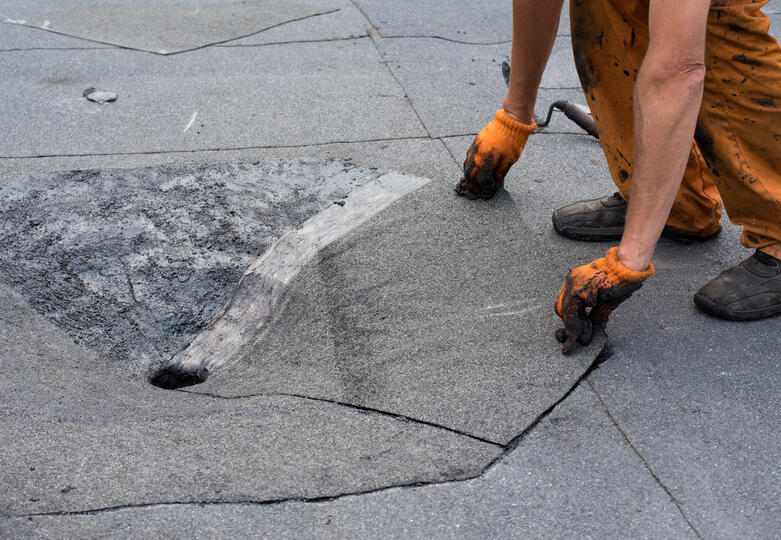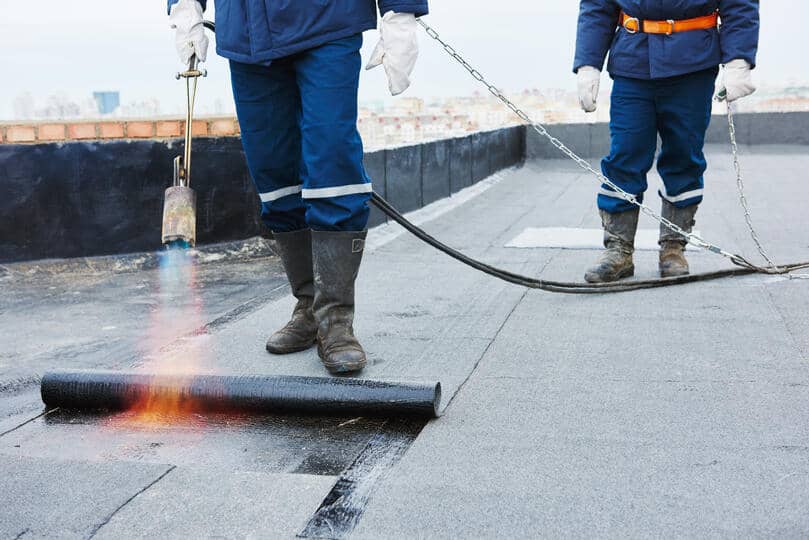Flat roofs are a common choice for commercial properties, offering a sleek, modern look and more usable space. However, they come with their own set of challenges, particularly when it comes to leaks. Property managers, knowing how to effectively repair flat roof leaks is crucial to maintaining your building and protecting your bottom line. In this guide, we’ll walk you through everything you need to know about flat roof leak repair, including:
- Why flat roof leaks are a serious problem
- Assessing the extent of the leak
- 7 steps to repair flat roof leaks on your building
- Preventative maintenance tips
🤔 Why Flat Roof Leaks are a Serious Problem

Flat roof leaks are more than just an inconvenience; they can lead to significant structural damage and costly repairs. Water intrusion can compromise insulation, lead to mold growth, and even damage electrical systems or personal belongings inside the building. Over time, untreated leaks can weaken the roof structure itself, making it more susceptible to collapse under the weight of snow or heavy rains. If leaks are not detected early, they can result in extensive water damage that requires entire sections of the roof or interior walls to be replaced. For these reasons, understanding the causes of flat roof leaks and taking proactive measures is crucial for any property owner. Regular inspections, maintenance, and prompt repairs can help safeguard your investment and prolong the life of your roof.
Understanding the Causes of Flat Roof Leaks
Understanding the causes of flat roof leaks is crucial for effective maintenance and prevention. By identifying the root issues, property owners can avoid costly repairs and extend the lifespan of their roofs.
Pooling Water
One of the primary causes of flat roof leaks is water pooling. Unlike pitched roofs, which have a natural slope that allows water to run off, flat roofs require a specific design to ensure proper drainage. If a flat roof does not have the correct slope or if drains become blocked, water can accumulate in certain areas. This standing water can lead to deterioration of roofing materials over time. As the water sits, it can seep through cracks or seams, eventually causing leaks inside the building. It’s important to regularly inspect and clear any debris from drains and gutters to prevent water pooling.
Membrane Damage
The protective membrane on a flat roof is a critical barrier against moisture. Over time, this membrane can suffer damage from various sources, including harsh weather conditions like heavy rain, extreme heat, or ice buildup. Additionally, foot traffic—whether from maintenance workers or HVAC technicians—can create small punctures or tears, compromising the integrity of the roof. Even minor damage, if not addressed promptly, can allow water to penetrate and lead to leaks. Regular inspections and maintenance can help identify and repair these vulnerabilities before they escalate into major problems.
Poor Installation
Sometimes, the root cause of a leak is poor installation. If the roofing materials were not properly adhered or if seams were not sealed correctly, your flat roof might be more susceptible to leaks. This can result from inexperienced contractors or the use of subpar materials. Poorly installed roofing can lead to future complications, including structural damage and increased repair costs. It’s vital to choose experienced professionals for installation and to ensure that all work meets local building codes and industry standards.
🔎 Assessing the Extent of the Leak
Assessing the extent of a leak is crucial for determining the potential impact on safety, the environment, and property. Understanding the severity helps in implementing effective containment and remediation strategies to mitigate further damage.
Interior Inspection
Start by thoroughly inspecting the interior of your commercial property. Look for water stains on ceilings and walls, mold growth, and any signs of water damage, such as warped materials. Documenting these areas not only helps you locate the leak but also provides evidence for insurance claims or repairs. It’s also important to check for odors that may indicate hidden moisture issues.
Exterior Inspection
Next, examine the exterior of the commercial roof for clear signs of damage. Look for punctures, cracks, or areas where the roofing membrane is peeling or bubbling. Pay close attention to sections where water tends to pool, as stagnant water can lead to structural damage over time. Check around roof penetrations, such as vents and chimneys, which are common leak points.
Professional Assessment
While conducting DIY inspections is beneficial, it’s crucial to schedule a professional assessment to accurately gauge the extent of the damage. Roofing experts possess specialized tools, like infrared cameras, to detect hidden leaks and structural issues that may not be visible to the untrained eye. Their expertise can help you prioritize repairs, ensuring your roof remains in good condition and preventing future leaks.
Signs of Damage
Identifying signs of damage is crucial for finding flat roof leaks because early detection can prevent more extensive and costly repairs down the line. Regularly checking for issues like cracks, blisters, or pooling water helps ensure the roof’s integrity and extends its lifespan.
- Visible Water Stains: Water stains on your ceiling or walls are a clear indication that your roof has a leak. These usually appear as discolored patches and should not be ignored.
- Mold Growth: Mold and mildew are common signs of prolonged moisture exposure. If you notice a musty smell or visible mold, it’s likely that there is a leak somewhere in your roofing system.
- Sagging Ceilings: If parts of your ceiling are sagging, this is a severe sign of water damage. This not only compromises the structural integrity of your building but also poses a risk to the occupants within.
- Blistering or Peeling Paint: If the paint on your walls or ceilings is blistering or peeling, it can be a sign of moisture accumulation behind the surfaces, often due to a roof leak.
- Increased Energy Bills: A sudden spike in your energy bills may indicate that your roof is not providing adequate insulation, potentially due to leaks allowing air to escape.
- Damp or Musty Odors: Persistent damp smells can indicate hidden leaks or moisture buildup within your structure that needs to be addressed.
- Cracked or Buckled Roofing Material: Visible cracks, buckles, or warped sections in the roofing material can signal damage and potential leaks that require immediate attention.
- Water Pooling on Roof Surface: If you see water pooling on your flat roof after rain, it may indicate poor drainage or leaks that need to be investigated and resolved.
🛠️ 7 Steps to Repair Flat Roof Leaks on Your Building

Repairing flat roof leaks is crucial to prevent water damage, which can lead to costly repairs and structural issues. Addressing leaks promptly ensures the longevity of your building and maintains a safe environment for occupants.
1. Clear the Area
Begin by removing any debris, dirt, or standing water from the affected area. This not only provides a clear view of the damage but also eliminates potential contaminants that could interfere with the repair process. Ensuring a clean workspace is crucial for a successful repair.
2. Identify the Leak Source
Carefully inspect the roof to pinpoint the exact location of the leak. Look for visible signs such as cracks, blisters, or punctures in the roofing membrane. It’s essential to conduct a thorough examination, as leaks can sometimes originate far from where water is entering the building.
3. Clean the Damaged Area
Once you’ve identified the leak, thoroughly clean the area surrounding it. Use a roofing cleaner designed for your roofing material to remove any grime or residue. After cleaning, ensure the surface is completely dry before proceeding, as moisture can undermine the effectiveness of repairs.
4. Apply a Temporary Fix
To mitigate further water damage while you prepare for a permanent repair, apply a sealant to the area. This temporary patch will help control leaks until you can gather the necessary materials for a more durable solution. Choose a sealant suitable for outdoor use and compatible with your roofing material.
5. Cut Out Damaged Membrane
Using a utility knife, carefully cut out the damaged section of the roofing membrane. Make sure to extend your cuts well beyond the visible damage to ensure that you are removing all compromised material. This step is crucial for achieving a proper seal with the new membrane.
6. Install New Membrane
Prepare the area by applying adhesive according to the manufacturer’s instructions. Then, install a new piece of roofing membrane, ensuring it overlaps the existing membrane adequately. Press down firmly to create a strong bond, and take care to eliminate any air pockets that could lead to future leaks.
7. Seal the Edges
Finally, seal the edges of the new membrane with a high-quality waterproof sealant. This step is vital for creating a watertight seal. Pay special attention to corners and overlaps, as these areas are most prone to leaks. Allow the sealant to cure as per the manufacturer’s recommendations to ensure optimal performance.
💡 Preventative Maintenance Tips

Preventative maintenance is crucial for commercial flat roofs to identify and address potential issues before they lead to leaks. Regular inspections and maintenance can extend the lifespan of the roof and save significant costs associated with water damage and repairs.
- Regular Inspections: Schedule regular inspections to catch potential issues before they become major problems. Aim for at least twice a year, ideally in spring and fall.
- Maintain Drainage Systems: Ensure that gutters, downspouts, and drainage systems are clear of debris. Proper drainage is crucial for preventing water from pooling on your flat roof.
- Prompt Repairs: Address minor issues as soon as they arise. Small repairs are easier and less costly than dealing with extensive water damage later on.
🙌 Protect Your Investment: The Importance of Timely Flat Roof Leak Repairs
Addressing flat roof leaks promptly is crucial to maintaining the integrity of your building and preventing extensive damage. With a thorough understanding of the causes, signs, and repair processes outlined in this guide, you can take proactive steps to safeguard your property. At Clean Cut Roofing, our team of experienced professionals is dedicated to providing high-quality roofing solutions tailored to your specific needs. We pride ourselves on our transparent communication, reliable service, and craftsmanship that you can trust. Don’t wait until a minor leak becomes a major issue—contact us today for a free assessment and let us help protect your investment with our expert roofing services!




